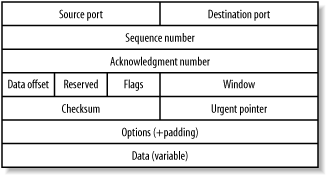6.3 TCP
| < Day Day Up > |
| TCP is a connection-oriented protocol that provides reliable, stream-oriented connections in an IP environment. TCP corresponds to the transport layer (Layer 4) of the OSI reference model. TCP guarantees delivery of packets to the application layer. This reliable delivery feature is based on sequence numbers that coordinate which data has been transmitted and received. TCP can retransmit any lost data. In addition, TCP senses network delay patterns and dynamically throttles data to prevent bottlenecks. Faster-sending hosts can be slowed down to let slower hosts catch up. TCP uses a number of control flags to manage the connection. 6.3.1 TCP FeaturesFeatures of TCP include the following:
6.3.2 TCP Packet Field DescriptionsThe following descriptions summarize the TCP packet fields illustrated in Figure 6-2:
Figure 6-2. A representation of TCP packet fields |
| < Day Day Up > |
EAN: 2147483647
Pages: 211